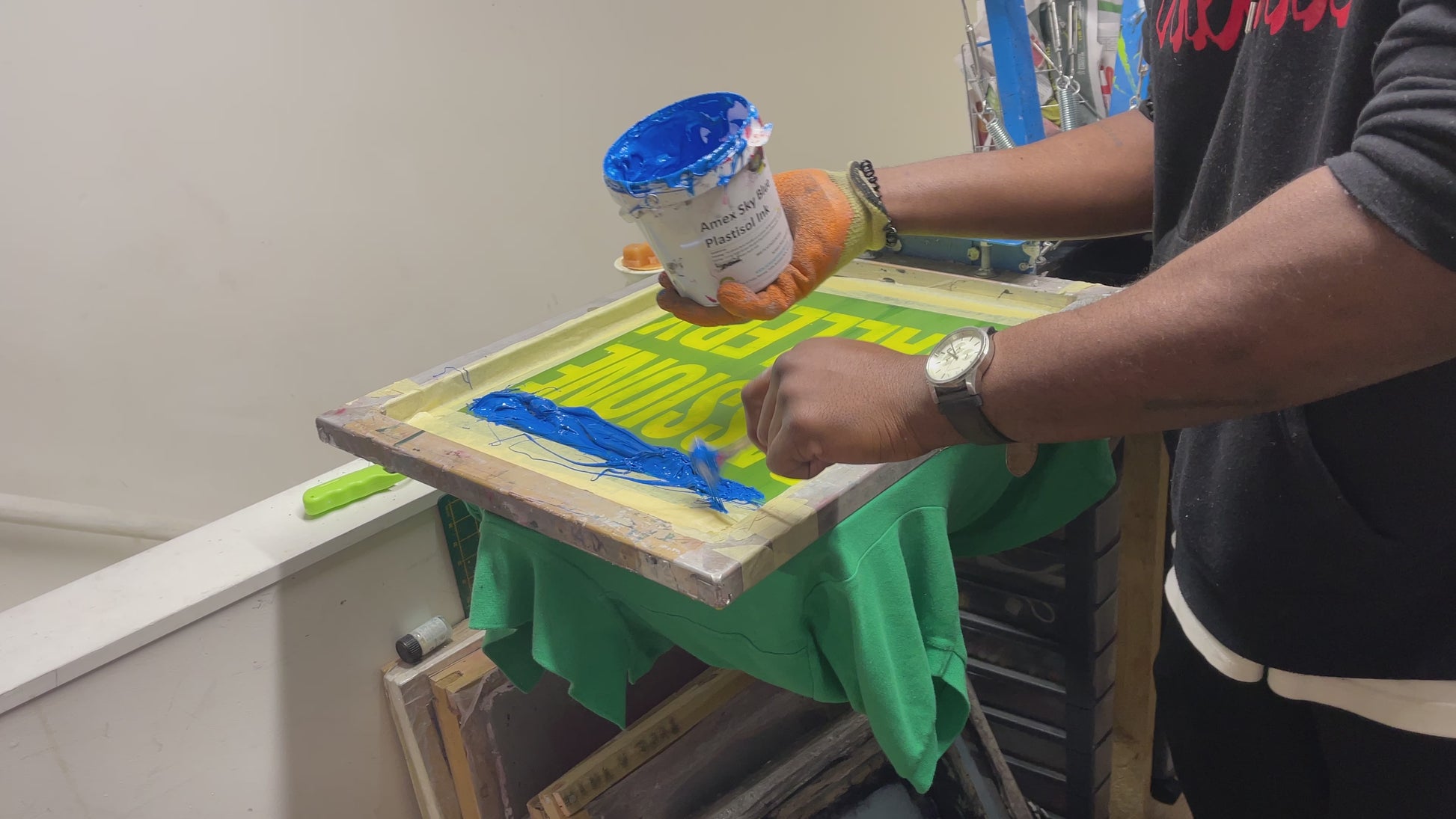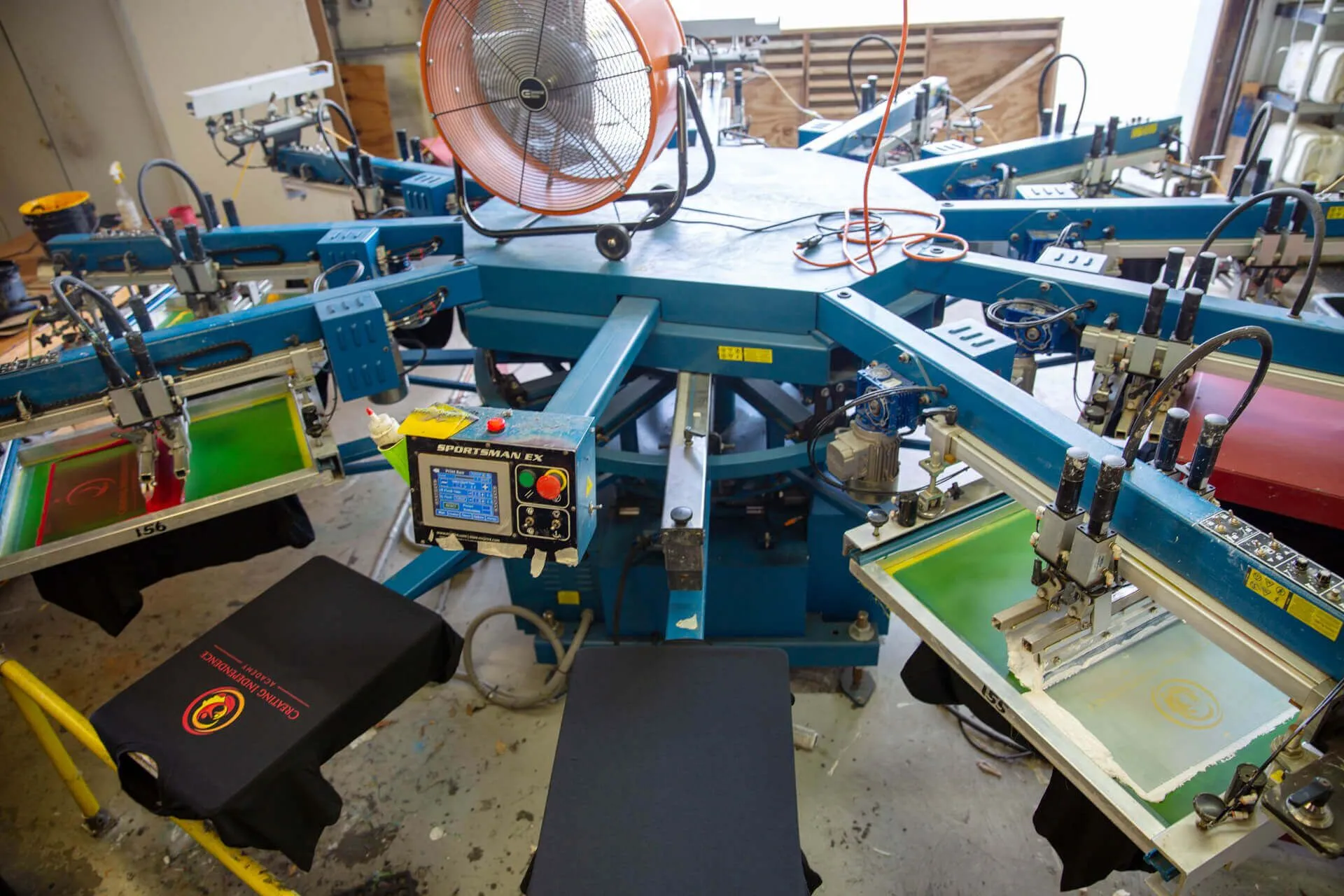Eco-Friendly Custom Screen Printing Options Available
Wiki Article
Display Printing Uncovered: Every Little Thing You Need to Know Regarding T-Shirt and Garment Printing Techniques
Screen printing is a fascinating approach that combines art with method, offering endless possibilities for creativity. Prepared to check out the necessary components that make display printing an art form?
The Basics of Screen Printing: Exactly How It Works
When you dive right into screen printing, you'll discover it's both a science and an art. At its core, screen printing includes developing a stencil, or display, that enables ink to go through just in specific areas (screen printing kit). You begin by choosing your layout and preparing your display with a light-sensitive solution. When you subject this solution to light, it sets, leaving your layout as a negative room.Position the display over the textile, then use a squeegee to press ink via the screen onto the garment. Each action is vital, and mastering them will raise your screen printing skills, transforming simple garments into unique, expressive items.
Kinds Of Display Printing Methods
Once you understand the fundamentals of screen printing, it's time to explore the numerous strategies that can boost your styles. One prominent approach is standard screen printing, where ink is pressed with a stenciled display. This method is great for strong, lively colors. Then there's water-based ink printing, which offers a softer feel and is eco-friendly, however it calls for a different technique to treating.One more option is plastisol printing, understood for its sturdiness and vivid shades, making it a preferred for lots of brands. Experiment with halftone printing to create slope impacts and elaborate layouts.
Essential Tools for Display Printing
To achieve sensational lead to screen printing, having the best equipment is basic. You'll need a tough display printing framework, which holds the mesh that moves your style onto the garment. Next, purchase top quality mops; these are essential for applying ink uniformly across the screen. You'll also require an excellent exposure unit to create your displays, as well as a washout booth for cleaning them after use. A reputable warmth source, like a conveyor clothes dryer or heat press, is vital for healing your prints to assure longevity. Don't fail to remember an appropriate office, geared up with tables and storage space for your supplies. Protective gear, such as gloves and masks, will certainly maintain you safe from chemicals and inks. With the right tools, you'll be well on your way to producing professional-quality prints.Selecting the Right Inks and Materials
When picking inks and products for screen printing, you require to consider the kind of ink that functions finest for your task. Consider fabric compatibility to assure your designs look wonderful and last long. Explore eco-friendly ink alternatives to make your printing procedure a lot more sustainable.Kinds of Display Inks
Choosing the best screen ink is important for accomplishing vibrant, sturdy prints that satisfy your project's demands. There are a number of types of display inks to analyze. Specialized inks, such as glow-in-the-dark or metallic, can add distinct results to your styles.
Material Compatibility Factors To Consider
Recognizing material compatibility is crucial for attaining top quality screen prints, particularly since different products respond uniquely to different inks. When choosing inks, take into consideration the textile type-- cotton, polyester, or blends. For cotton, water-based inks function well, offering softness and breathability. Polyester, on the other hand, typically needs plastisol inks for better bond and vibrant colors. You could require to use a combination of both types if you're publishing on blends. Constantly examine your inks on sample textile to ensure they stick properly and preserve shade stability. Additionally, remember that fabric weight and texture can influence the last outcome, so choosing the appropriate ink and material combo is crucial for your job's success.Eco-Friendly Ink Options
Environment-friendly inks are becoming a popular choice for screen printers who desire to minimize their environmental impact while maintaining quality. When picking inks, take into consideration water-based inks, which are much less harmful and much easier to clean up compared to typical solvents.Furthermore, search for inks made from renewable energies, such as soy or vegetable-based options. By selecting the right inks and products, you'll not just create magnificent layouts yet additionally contribute to a more sustainable printing procedure. Make the button, and your prints will certainly mirror your dedication to the atmosphere!
Preparing Your Design for Screen Printing

File Layout Demands
To assure your design looks vivid and sharp on fabric, you'll require to pay close attention to submit layout needs for display printing. Start with vector data like AI or EPS, as they can be scaled without losing high quality. If you utilize raster images, choose high-resolution files, such as TIFF or PNG, preferably at 300 DPI. Avoid utilizing JPEGs, as they can shed quality when resized. Also, ensure your style has a transparent history to stop undesirable white sides on your prints. Maintain color settings in mind; CMYK is typical for screen printing, so convert your RGB designs appropriately - screen printing kit. By complying with these guidelines, you'll establish your artwork up for a successful print.Shade Splitting Up Strategies
Color splitting up is a vital action in preparing your design for screen printing, and understanding it can considerably improve your print quality. You'll require to break your layout right into specific shades, as each shade needs a separate screen throughout printing. Begin by recognizing all the shades in your style and produce layers each. You can make use of software program like Adobe Photoshop or Illustrator to separate and different colors successfully. Be specific to save each layer as a separate documents, typically in a layout like TIFF or PSD. This accuracy not only assures exact color representation however additionally improves the printing procedure. By focusing on color splitting up, you'll attain specialist and vibrant cause your screen-printed garments.Resolution and Size
Accomplishing the most effective cause screen printing begins with assuring your style has the right resolution and dimension. Preferably, your art work needs to go to the very least 300 DPI (dots per inch) for sharp, clear prints. Your last item might look less than professional and pixelated. if you use reduced resolution.When it concerns dimension, think about the dimensions of your print location. Design your artwork to match the last print size, preferably developing it in the real measurements you'll be printing. In this manner, you'll stay clear of any kind of unexpected scaling problems.
Constantly inspect your layout in both vector and raster layouts. Vector graphics can be scaled without losing top quality, making them excellent for screen printing. Preparing correctly will ensure your design looks incredible on every garment!
Step-by-Step Display Printing Refine
Display printing is a vibrant process check my site that allows you to create dynamic designs on numerous surfaces. To start, you'll need a display, solution, and your selected ink. First, prepare your screen by cleaning it completely. Next, apply the emulsion equally and allow it completely dry in a dark area. Once dry, reveal your screen to light with your layout positioned on it, which will certainly harden the solution where the light hits, producing a stencil - screen printing kit.After washing out the unexposed emulsion, your display prepares. Establish it up on your printing surface area and straighten your garment below it. Pour ink onto the screen and utilize a squeegee to push the ink via the pattern onto the fabric. Lift the display carefully and let the print dry. Heal the ink making use of warm to ensure toughness. That's it! You've successfully display printed your layout.
Tips for Effective Screen Printing Projects
While you're diving into your screen printing projects, bear in mind that prep work is vital to success. Start by gathering all your materials-- inks, mops, screens, and garments. A tidy office aids avoid undesirable mistakes, so clean up before you start.Next, validate your artwork is high-resolution and correctly sized for your garment. Evaluate your screen for appropriate direct exposure and tidy it extensively to stay clear of smudges. When mixing your inks, adhere to the manufacturer's standards to accomplish the best consistency.
Throughout printing, apply also pressure with your squeegee for regular results. Don't hurry; take your time to confirm each print meets your standards. After printing, let page your garments dry entirely prior to dealing with or packaging them.
Last but not least, constantly maintain a sample of your help future recommendation. This method, you can examine your progress and enhance your methods over time. Happy printing!

Frequently Asked Inquiries
For how long Does It Take to Establish a Display Printing Task?
Establishing a screen printing job normally takes around thirty minutes to an hour. You'll prepare the screens, mix inks, and readjust journalism. The moment differs based upon intricacy and experience, so remain arranged!Can I Print on Various Material Types Making Use Of the Exact Same Strategy?
Yes, you can publish on different textile types utilizing the same method, yet you'll require to readjust your setups and inks. Some textiles take in ink differently, so trying out warranties the most effective outcomes for each material.What Are Common Blunders to Prevent in Screen Printing?
When display printing, prevent typical errors like utilizing the incorrect ink, ignoring proper exposure times, or skipping pre-press checks. Always evaluate your configuration and keep tidy screens to assure top quality results each time.Exactly How Can I Correctly Clean and Keep My Display Printing Devices?
To correctly tidy and preserve your screen printing tools, you should consistently wash screens with proper solvents, inspect mops for wear, and ensure all devices are saved completely dry and dust-free. Uniformity improves and protects against pricey repair services efficiency.Is Screen Printing Eco-friendly Compared to Other Techniques?
Screen printing can be extra eco friendly than various other methods, particularly if you use eco-conscious materials and water-based inks. By choosing lasting materials and methods, you decrease waste and minimize your influence on the earth.Display Printing Uncovered: Everything You Need to Know Regarding T-Shirt and Garment Printing Techniques
At its core, display printing involves creating a pattern, or screen, that allows ink to pass with only in details areas. Setting the display over the fabric, then utilize a squeegee to push ink via the display visit this website onto the garment. One preferred technique is traditional screen printing, where ink is pressed through a stenciled screen.When picking inks and materials for display printing, you need to take right into account the type of ink that works finest for your project.
Report this wiki page